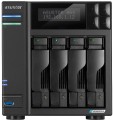Add to comparison |  |  |
|---|---|---|
| ASUSTOR Lockerstor 6 Gen2 RAM 8 GB | ASUSTOR Lockerstor 4 Gen2 RAM 4 GB | |
| Compare prices 3 | Compare prices 3 | |
| TOP sellers | ||
| Mount | desktop | desktop |
Drives | ||
| 3.5" drive slots | 6 | 4 |
| Hot swap | ||
| SATA 2 | ||
| SATA 3 | ||
| M.2 connector | 4 | 4 |
| RAID | RAID 0 RAID 1 RAID 5 RAID 10 JBOD Single, RAID 6 | RAID 0 RAID 1 RAID 5 RAID 10 JBOD Single, RAID 6 |
Connection | ||
| LAN ports | 2 | 2 |
| LAN speed | 2.5 Gbps | 2.5 Gbps |
| USB 3.2 gen1 | 2 | 2 |
| HDMI | v 2.0 | v 2.0 |
Features | ||
| Software features | Web server FTP server multimedia (DLNA, iTunes, uPnP) transcoding BitTorrent client mail server video surveillance server backup DDNS virtualization | Web server FTP server multimedia (DLNA, iTunes, uPnP) transcoding BitTorrent client mail server video surveillance server backup DDNS virtualization |
Hardware | ||
| CPU | Intel Celeron N5105 | Intel Celeron N5105 |
| CPU cores | 4 cores (4 threads) | 4 cores (4 threads) |
| CPU speed | 2 GHz | 2 GHz |
| TurboBoost frequency | 2.9 GHz | 2.9 GHz |
| RAM | 8 GB | 4 GB |
| Max. RAM | 16 GB | 16 GB |
| RAM slots | 2 | 2 |
| Built-in memory | 8192 MB | 8192 MB |
| Control | WEB-interface / app | WEB-interface / app |
General | ||
| Power consumption | 48.5 W | 35 W |
| Screen | ||
| Cooling | active | active |
| Noise level | 18 dB | 18 dB |
| Size | 186x233x230 mm | 186x170x230 mm |
| Weight | 4.4 kg | 2.94 kg |
| Added to E-Catalog | july 2022 | july 2022 |